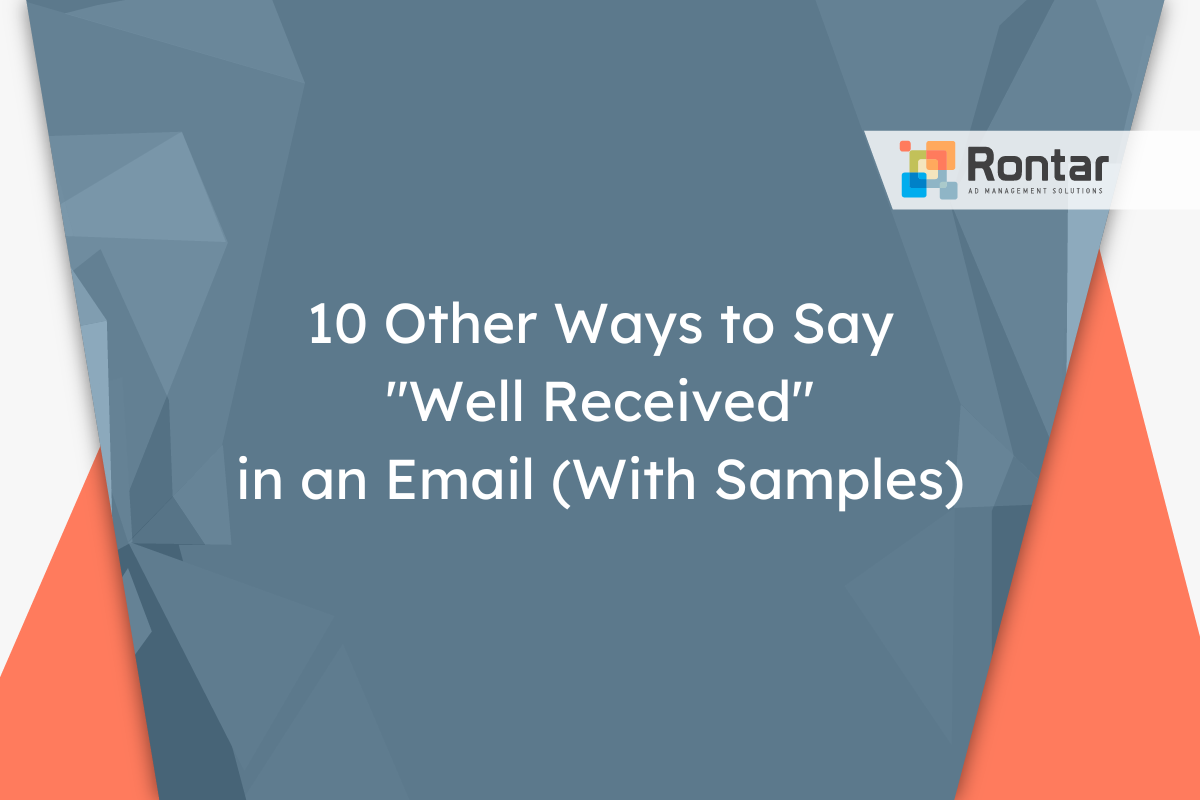10 Other Ways to Say “Well Received” in an Email (With Samples)

Email communication is a big part of professional life, and it’s important to express yourself clearly and respectfully. Sometimes saying “Well received” can feel repetitive or too formal.
In this article, we explore 10 different ways to acknowledge you’ve received an email, each with examples and tips on when to use them.
Is It Professional to Say “Well Received”?
When it comes to professional email communication, the phrase “well received” is considered professional, formal, and polite. It’s a concise way of acknowledging that you have received someone’s email or document, and it implies that the contents have been understood or are being considered. This phrase is best used in business emails where you want to confirm receipt of important documents, feedback, or information in a formal and respectful manner.
Here’s an example of using “well received” in a professional email:
Hello Mr. Brown, Thank you for sending over the project documents. I want to confirm they were well received. We will review them and get back to you with any questions by the end of this week. Kind regards, Samantha Lee Project Manager
Now, let’s consider the pros and cons of using this phrase.
Pros:
- Shows professionalism by acknowledging receipt of information.
- Communicates clear understanding or acceptance without much detail.
- It’s concise, making it suitable for professional settings.
Cons:
- Can be seen as overly formal in more casual business environments.
- May lack warmth or personal touch.
- Doesn’t provide specific feedback or next steps.
While “well received” is generally a solid choice for professional emails, there might be situations where you want to use an alternative phrase. If you’re in a more relaxed work environment or looking to add a bit more personality to your emails, considering synonyms or alternatives can be beneficial. Alternatives might convey the same message but in a way that’s more aligned with your personal or company voice. It can also help avoid repetition if you find yourself using “well received” too frequently. Sometimes, a synonym can add clarity or warmth, depending on the context and the relationship you have with the recipient.
10 Other Ways to Say “Well Received” in an Email
If you’re looking for a fresh way to acknowledge an email, here are ten alternatives to the phrase “well received.”
- Thank you for your email
- I have received your email
- Thank you for the information
- Received
- Understood
- I have received and understood your email
- Accepted
- Agreed
- Approved
- Received and understood
1. Thank you for your email
Compared to “well received,” “Thank you for your email” adds a personal touch and is perceived as polite and friendly. This alternative is slightly more informal but still perfectly acceptable in most professional settings. It’s an excellent choice when you want to acknowledge receipt of the message and express gratitude.
This alternative is better suited when you’re responding to someone who has taken the time to give you detailed information, ask thoughtful questions, or address a concern. It’s especially useful in customer service or when initiating a friendly rapport with a new contact.
Here’s a simple example of using this phrase in an email:
Hi Alex, Thank you for your email. We appreciate your suggestions and will discuss them in our next team meeting. Best regards, Jessica Lane
2. I have received your email
This alternative is very formal and professional. It’s straightforward and directly acknowledges the receipt of an email without adding any emotional tone. While it’s clear and precise, it may come across as slightly detached.
We recommend using this phrase when you need to clearly acknowledge receiving important, possibly time-sensitive documents or information but don’t need to provide an immediate, detailed response. It’s particularly useful in formal business contexts where clarity is paramount.
Here’s how you can use it in communication:
Dear Mr. Thompson, I have received your email concerning the contractual agreement. I will review the documents and revert by tomorrow. Kind regards, Sandra Green
3. Thank you for the information
This phrase is a polite and appreciative way to acknowledge receipt of information. It’s slightly more informal than “well received” but maintains a professional demeanor. It has a warm tone and is great for building a positive relationship with the sender.
It’s better suited for emails where specific, useful information was provided. This makes the sender feel their effort was worthwhile. Use this in situations where you want to express gratitude and show that the information provided was valuable to you.
Use this example in your next email:
Hi Veronica, Thank you for the information you shared about the new marketing strategy. It's very insightful and helpful. Warmly, Tom Hardy
4. Received
“Received” is the most informal alternative and should be used cautiously in professional emails. It immediately indicates that the message has been received but lacks the personal touch or politeness of other options. This alternative works when time is of the essence, and the conversation has already been established as informal.
This alternative might be better suited for quick, internal communications among team members who are already comfortable with each other. It’s not the best choice for first-time communications or with individuals outside your immediate team.
Quick and direct, here’s how you might use it:
Hey Jordan, Received. I'll get on it now. Cheers, Mia
5. Understood
“Understood” is both professional and formal, conveying that not only has the message been received, but its contents have been comprehended as well. This phrase adds a layer of understanding that “well received” does not explicitly convey.
This synonym is particularly effective in situations where the sender has requested confirmation of understanding specific instructions or information. We recommend using it when you want to affirm that you not only received the information but also grasped its significance.
A professional example would be:
Hello Brenda, Understood. I'll ensure the project aligns with the new guidelines you've outlined. Best, Kyle Jensen
6. I have received and understood your email
This phrase is both professional and comprehensive, indicating that you have not only seen the email but also fully understood its contents. It’s more formal than many of the alternatives and ensures there’s no ambiguity about your response.
It’s particularly suited for scenarios where clarification or detailed responses are expected. Using this phrase sets a clear expectation of your comprehension and readiness to proceed based on the email’s content.
For clarity and confirmation, consider this template:
Hello Ms. Patel, I have received and understood your email regarding the proposed budget changes. I agree with your suggestions and am ready to discuss them further. Kindly, Gregory Diaz
7. Accepted
“Accepted” implies a formal agreement or consent to a proposal or offer. It’s more formal and specific than “well received,” indicating a positive response to the received message. This word is most appropriate in contexts where an agreement, offer, or proposal is involved.
Use this alternative when you want to formally agree to something that has been proposed in an email. It’s straightforward and leaves no room for uncertainty regarding your stance.
Formal acceptance can be conveyed like this:
Hello Dr. Hansen, Accepted. I look forward to contributing to the research project. Sincerely, Elena Torres
8. Agreed
Likewise, “Agreed” is a direct and formal way to show that you are in line with what’s been stated or proposed in the email. It suggests a mutual understanding or conclusion has been reached. While formal, it also carries a sense of collaboration.
This is an excellent choice for emails where decisions or plans requiring mutual consent are discussed. It signifies your concurrence with the sender’s points or proposals.
A fitting example of agreement:
Dear Committee Members, Agreed. The proposed meeting date works for me. Regards, Evan Roberts
9. Approved
“Approved” is a formal and authoritative alternative, indicating that you have the authority to give a final say and have done so in favor of the proposal or request. It’s more categorical than “well received,” showing decision-making power.
This alternative is better suited for emails where you’re in a position to approve requests, proposals, or decisions. It communicates a clear endorsement and decision to proceed with what has been proposed.
Here’s how to use it in a decision-making context:
Hello Team, Approved. Please proceed with the marketing campaign as outlined. Best, Olivia Martin
10. Received and understood
Lastly, “Received and understood” is a combination that’s both professional and thorough. It leaves no doubt that you’ve received the email and comprehended its contents. It’s more detailed than simply saying “received” and ensures clarity.
This phrase is particularly useful when you need to assure the sender that you’re fully on board with the instructions or information provided. It’s excellent for formal communications where clarity is crucial.
An example to clarify receipt and understanding:
Hi Logan, Received and understood. I'll start working on the tasks as per your instructions. Kind regards, Rachel Kim
Final Thoughts
Choosing the right way to acknowledge an email is important in maintaining professionalism and clarity in your communications. As we’ve seen, alternatives to “well received” range from the formal to the informal, allowing you to adjust your tone based on the situation and your relationship with the recipient.
Remember, the goal is to ensure the sender knows their message has not only been received but also understood, accepted, or agreed upon. By varying your responses, you keep your emails fresh and engaging while also making your intentions clear. Next time you find yourself reaching for the standard “well received,” consider one of these options instead to enhance your email etiquette.






